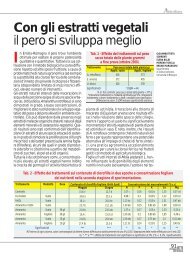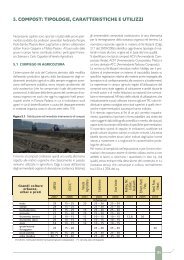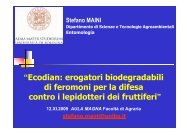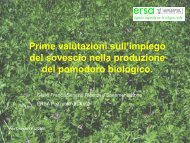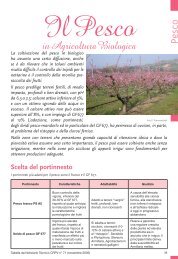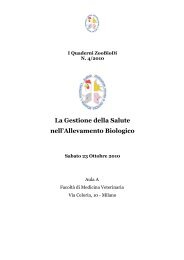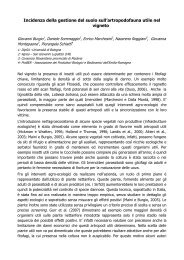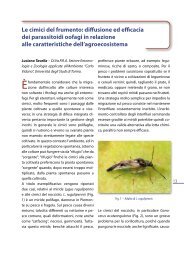You also want an ePaper? Increase the reach of your titles
YUMPU automatically turns print PDFs into web optimized ePapers that Google loves.
Petria 20 (1), 1-72 (2010) – Atti Convegno - Ancona, 26 Febbraio/February 2010una migliore protezione nei primi due anni, intervallati con i due prodotti alternativi.La distribuzione dei formulati è stata effettuata in due areali diversi della regione(Camerano e Montecarotto), su due diverse varietà (Verdicchio e Montepulciano), siasecondo una strategia a calendario, sia in base al rischio epidemico.Nelle prove di efficacia svolte in campo nel 2007 e 2008, i composti rameicihanno fornito una buona protezione, rispetto al testimone, anche alle dosi più basse,seppure in presenza di bassa pressione di malattia, come anche i prodotti alternativi,anche se in misura più limitata. Nel terzo anno di sperimentazione non sono stateosservate differenze significative fra i calendari di trattamento e fra le tesi a confronto,evidenziando una buona efficacia dei prodotti alternativi quando intervallati con icuprici, anche usati a dose ridotta. Tali prodotti alternativi possono quindi risultareutili in alternanza ai rameici in periodi della stagione vegetativa caratterizzati da bassapressione della malattia, al fine di limitare gli apporti cuprici.Parole chiave: Difesa biologica, Difesa integrata, Peronospora della vite, Strategie diprotezione, Vitis vinifera.Evaluation of the effectiveness of copper formulations used at reduced ratesand of alternative compounds in the control of Plasmopara viticolaOver the last 20 years, copper application has become ever more consideredas the basis for control of downy mildews (Brunelli, 1995). This has produced someconcerns about its environmental destiny due to its low degradability in the soil(Agnelli et al., 2002). This environmental problem was resolved by legislation throughthe application of Regulation (EC) 473/2002, which imposed progressive reductionsin copper application in agriculture. This disoriented the organic viticultural farmers,as copper formulations continued to guarantee effective protection in the control ofPlasmopara viticola (Berk. et Curt.) Berl. et de Toni, the agent of downy mildew, whilealso stimulating pluriannual field trials in the main Italian viticultural areas that wereaimed at optimizing copper treatments and exporing possible alternatives (Bortolottiet al., 2006; Egger and D’Arcangelo, 2006; Sancassani et al., 2006; Dongiovanni etal., 2008).In the framework of a three-year project funded by the Marche Region, weevaluated the possibility of using copper at reduced doses, and also of alternativecompounds, for the control grapevine downy mildew in the pedoclimatic, cultural andvarietal conditions of this region.In the first two years of these trials, the effectiveness in the control of downymildew of three doses (average suggested rate, 70% and 40% of this) of nine copperformulations was evaluated, based on copper hydroxide (Kocide 2000 and CuprantolUltra micron), copper oxychloride (Rame Caffaro blu), tribasic copper sulphate(Cupraxat SDI), Bordeaux mixture (Poltiglia Caffaro 20 DF and Poltiglia BordoleseDisperss), dicopper oxide (Cobre Nordox Super 75), copper peptidate (Tepan),10



